Employee

Comms

Tips
5 Employee Communication Tips every HR Professional Should Know

Introduction
The five tips outlined in this guide will help you craft employee communications that will encourage people to take a desired action, build trust, and decrease anxiety.
Survey the average employee and they will likely tell you they are overwhelmed. In fact, in a study of almost 2,000 office workers, 25% of employees report feeling overwhelmed.
What’s that like? “There is a sense that it's all just 'too much' – there is a constant stream of notifications, there is so much to do, and in a digital world you feel like you’re always connected – the lines between work and home become blurred and you feel like you can never step away.”
Knowing our employee’s mindset can help us craft communication that decreases stress instead of increasing it.
What’s at stake if HR Communications fall short?
We risk losing trust and credibility if we don’t communicate well with our employees. On the other hand, if HR communications are impactful, the benefits are clear: valuable time saved and decreased stress for both HR and employees.
Employees don’t want to waste their time and neither do we. We want to spend time crafting comms that matter and that ultimately save time, helping us be proactive, not reactive. With better communication, you can show employees you understand and recognize their unique needs.
Wading through an ocean of information
The truth is, employees can get information on their own. What they need from us is information that connects to what they care about. They need information that helps them do their job better and enhances their performance.
Every time they read an email, they’re scanning for what’s applicable, relevant, and personal to them. We all do this (you may be doing this now!). It’s normal and natural to connect information we receive to our own specific needs.
There is an extra burden on new hires or newly promoted employees
It’s not uncommon for new hires to be bombarded with long messages from multiple sources, often sent all at once. This is an added burden as they they try to learn the ropes of a new role and organization. The same can be said for new managers.
These transition moments in an employee’s journey are often when they need our support and help the most - yet new managers often find themselves on either side of an extreme - either waddling through too many new messages or receiving no help at all.
Employees are inundated with emails and messages
Communication fatigue is very real. According to a study by PoliteMail, employees have seen a 100% spike in email communication since COVID. Another study by Project 2.0 found that 80% of employees dislike their organization's employee communication.
With more communication than ever for the average employee, it’s not just the quantity of communication that can cause stress and anxiety. Knowing what to take action on and what needs our attention - especially in the limited amount of time we have - can be stressful.
The five tips outlined in this guide will help you craft employee communications that will encourage people to take a desired action, build trust, and decrease anxiety.

Lindsey Caplan
As Founder and Lead Consultant at The Gathering Effect, Lindsey partners with business and HR Leaders, chiefs of staff, and marketing professionals to define, diagnose, and adjust their company events and communication for the effect they want.

Tip One: Know your outcome
Draft your communication with the end goal in mind to write an effective message
Start drafting your communication with the end in mind. What do you need from the people you’re trying to affect? If we don’t know what we need, how will our employees know?
When writing communications, ask yourself these questions about the outcome:
- Who is this communication for?
- What do you want them to do differently after they read this message?
- Why would they read this?
- What information do your employees need?
- What is the key action step?
Know your communication outcome: inform or comply
Two common outcomes are complying and informing - meaning, is there an action you need employees to take (comply), or are you sharing a message (inform)?
We've provided examples below.
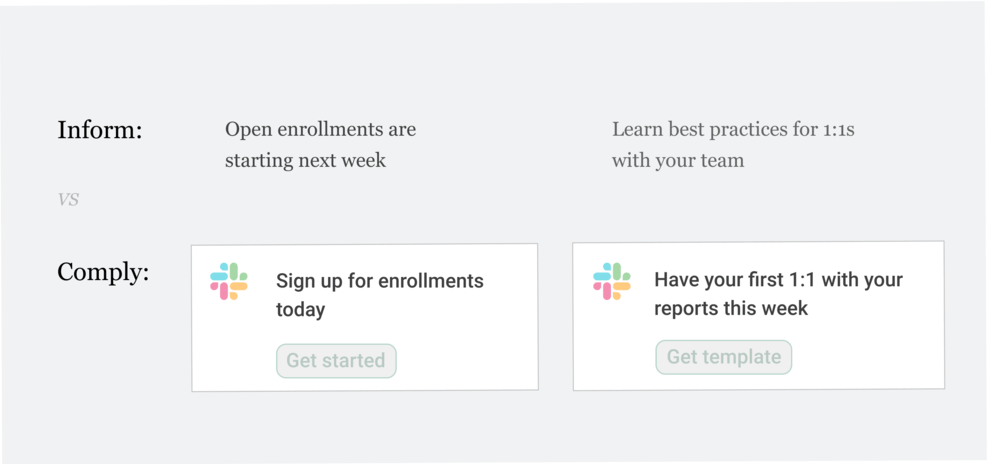
If there is a clear ask of the employee, clarify it upfront.
If you’re sending multiple messages over a period of time (for example, onboarding), separate the messages into those that require compliance (complete your onboarding paperwork) versus informing (read our intranet policy).

Tip Two: Have a helpful headline
Get employees to open your communication with a headline that works
Headlines determine if people want to click to open your message and spend their time and attention reading it. If employees click, they’ll read.
Pyn’s user research shows a strong correlation between someone clicking an email and reading it fully. But getting clicks is harder than you may think - that’s why it’s important to have a helpful headline that benefits the reader.
Ask yourself, “What’s the promise we’re making to our employees if they open this email?”
It’s not always necessary for your headlines to include all four tips outlined below, especially if there is no urgency for employees to complete a task. But when there is a specific action you want them to take, the clearer you can be about why + when + how and for who, the better.
1. Avoid jargon
Our brains like certainty - jargon doesn’t help. Leave out jargon in favor of clear and concrete language.
This helps in two ways:
- It relaxes the brain and makes it easier to digest information because our brain knows how to orient what’s to come.
- It builds trust. Don’t waste employees’ precious cognitive resources on asking them to guess on their own what’s inside or decipher fancy HR speak (competencies, anyone?). Instead answer, what’s the ‘so what?’ of the jargon.
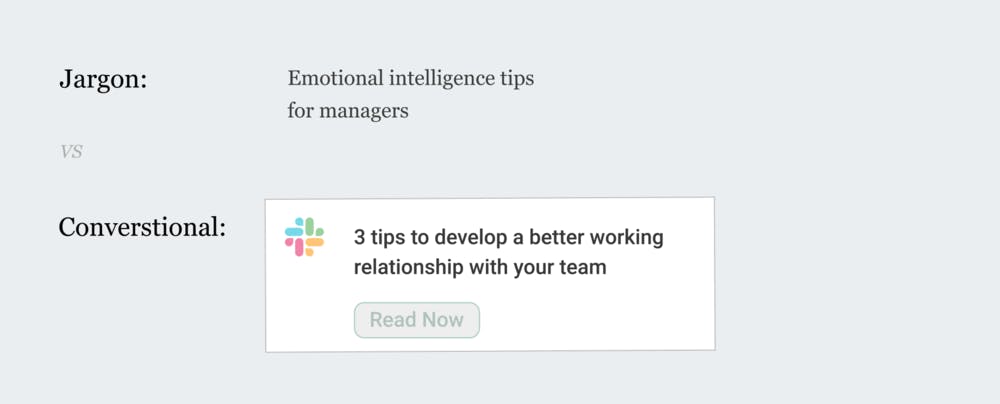
2. Include an action
Data from early Pyn customers show action-oriented headlines perform better. Choose the action you want employees to take instead of just the topic. Action-oriented subject lines clarify the promise of what’s inside if they click and are another way to build trust.
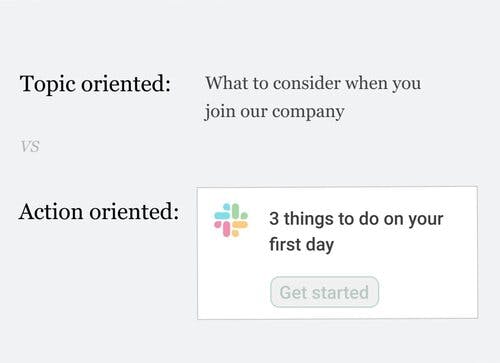
3. Personalize it
Early Pyn data also shows personalized subject lines tend to perform ~10% better.
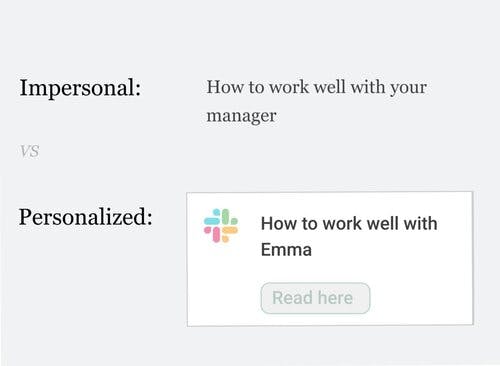
4. Make it time-bound
Tell your employees not just what you need them to do or pay attention to, but by when. Use the formula: Task + Time.
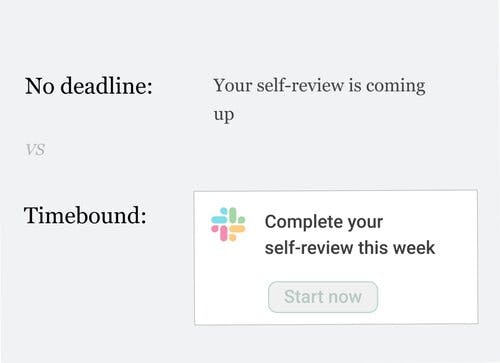

Tip Three: Don’t overpack your communication
It’s not about the length of the message, or how much information it contains, but the employee’s ability to do something with it.
With employee communication we think as long as we’re sending a message, it’s best to give employees as much information as we can. But this might not be the best way forward.
Resist the urge to overpack your communication, because overpacking messages makes for a heavy cognitive load.
Cognitive load refers to the amount of information that our working memory can hold at one time. According to the Cognitive Load Theory developed by John Sweller, the way we share information can either aid or obstruct that working memory. This is especially true if the content is complex or not directly relevant.
Our ability to use and be affected by the messages we receive isn’t a matter of quantity - how much information it contains. It’s a matter of quality - that the information is relevant, applicable, and personal.
It’s not about the length of the message, or how much information it contains, but the employee’s ability to do something with it.

Tip Four: Be action oriented
Make it clear what actions need to be taken from your communication
Tell your employees what to do (it's not rude, it's helpful).
Employees want to know what’s expected of them. This is especially true when someone is going through a new moment in their employee journey, like onboarding. That’s one reason why we can support our employees by being action-oriented, not just informational.
While we may believe it’s friendly to use casual or fun language, it can get in the way of our message being read. It also makes it harder to decipher what’s most important. If we’re not careful this can create more noise than signal.
An employee is scanning your message looking for clues on how to be successful, “Okay, but what do you need me to do?” Make it easy by telling them.
First, group asks and put them at the top of your message. If you have several asks, try to have them all be positive (things to do) or negative (not to do).
Second, decipher what the action looks like in an employee’s context. Focus on describing actions in observable behaviors. You can even give employees scripts or prompts of what to say, for example, “Say this when starting a difficult conversation.”

Use Pyn’s action continuum
The same message can be said in many ways, often on a continuum from informational (learn about) to actionable (do now).
That’s why we created Pyn’s action continuum to measure how actionable your communication is.

While not all messages can be on the “most preferred” end of the continuum, see if there are opportunities to shift your message from knowing to doing.

Tip Five: Match the message to the moment
The timing of your messages matters
Ever try yet fail to recall what you learned at new hire orientation after even a few months on the job? Our ability to recall information is harder the further away from the moment of need it is.
Instead of sending your communications all at once, make it timely by matching the message to the moment. Communicating in the flow of work is easier for employees to remember and to action.
For example, send a message to managers about how to have great 1:1’s in their first week as a manager - a time when many will be looking for this information and practicing this skill for the first time.
With Pyn you can automate messages to send exactly when an employee needs it, based on data in your HRIS. For example, you can send a sequence of messages to a new hire, triggered by their start date with in your HRIS
Talk about the timeframe
Labeling an email with a time frame is helpful, for example, “Welcome to Week 2 as a new manager.” You can take this one step further by connecting the “when” to the “what.”
When: In their second week, what are they trying to accomplish?
What: What might a new managers need be in their second week? What’s happening for them right now?
Connect tips to a concrete need
Help employees “land the plane” by directing them where and when to use the information you’re sharing.
This also helps your message feel more real and applicable by connecting it to a critical incident.
Concrete need: “Try this tip in your next team huddle”
General best practices: “Communication tips for teams”

Summary
It’s not just the message we share, it’s how and when we share it.
Communication is harder now because there’s so much content competing for the limited attention spans of highly stressed workers. We can decrease stress and anxiety (which is no friend to learning) by providing certainty through written communications. Give employees clarity on what’s expected of them and what they need to do.
Our job is to help people do better, not simply to share content. We need to close the gap between the utility of the information and our employee’s ability to do something with it.
The solution is not to give more information and comms, but to bring the message we want to share closer to those we want to share it with.
When you know your outcome, have a helpful headline, don’t overpack your messages, keep it action oriented, and match the message to the moment, you can communicate with employees more effectively.
